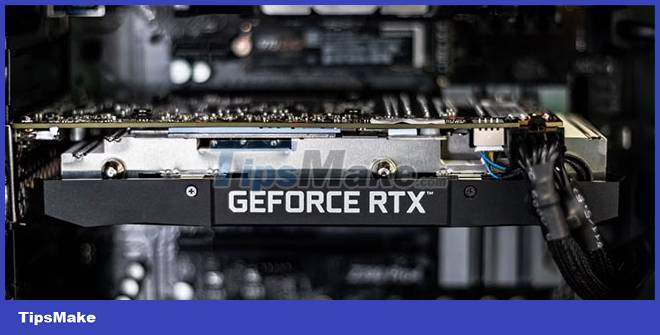Difference between desktop GPU and laptop GPU
If you're wondering whether to build a gaming PC or buy a gaming laptop, you may be thinking about GPU issues. Let's say your final choice is to weigh between a gaming desktop and a gaming laptop equipped with an RTX 3080 Ti.
However, the laptop, although more expensive and uses the same GPU, seems to run the game slower.
You are not mistaken! The smaller space inside a laptop shouldn't be the reason your games run slower. The main reason is because desktop GPUs and laptop GPUs are fundamentally different things.
How do desktop GPUs work?

The graphics processor inside the desktop is what you usually call a "graphics card". They are very simple in design. A GPU die in a printed PCB, connected to a PCI Express bus and multiple rear ports. You buy it and plug it into your computer's PCI Express slot. Then you screw the PCI bracket into the computer case to keep it in place, plug in the HDMI/DisplayPort cable connecting your GPU to the monitor and now you should have the image on the screen.
With gaming becoming more and more demanding, GPUs have adapted and evolved to accomplish that task. For this reason, it is common to see graphics cards with large power connectors (maybe even two or three depending on the graphics card's power requirements), extreme cooling solutions and fans. great.
Desktop GPUs are power-hungry and, as a result, they also give off a lot of heat. However, that's usually not a problem for desktops. Desktops often have a generous amount of space inside and depending on the airflow of the case, it allows the card to breathe and escape the heat that the graphics card generates.
How does laptop GPU work?

Laptops obviously can't match a full, full graphics card, at least there will be a few trade-offs. Most laptop GPUs work because separate lines of laptop GPUs are made to fit the thin profile of laptops. They need to meet a range of requirements, such as being small enough to fit in a laptop, powerful enough to run the latest AAA titles, and efficient enough that the laptop won't overheat, and the battery won't take a toll.
Therefore, laptop GPUs are fundamentally different products from desktop products. Power efficiency is an important part here. Laptops can take many steps to reduce power usage, including keeping an integrated GPU for battery saving purposes.
What is the difference between desktop GPU and laptop GPU?

The biggest priority on a laptop GPU, aside from running games well, is to keep power consumption as low as possible. While laptop and SoC manufacturers take steps to maintain those goals, often the most basic solution to reduce power consumption is chosen. That makes the actual GPU weaker.
The reason separate GPU lines exist for desktops and laptops is that you can't just throw an Nvidia RTX 3090 Ti in a laptop and expect everything to go smoothly. The most likely scenario is that, unless it's really thick or has some miraculous heat dissipation, your laptop will catch on fire and the battery will melt within two days. However, the fact that desktop and laptop GPUs are separate products may not be immediately obvious to most users.
Take for example the RTX 3080 Ti. The desktop version of this graphics card is on another level. It's an absolute monster with best-in-class 4K gaming. However, the laptop version of the RTX 3080 Ti is similar to the desktop RTX 3070 in terms of performance. It's still really good, but it's probably not the level of performance you'd expect from an RTX 3080 Ti-equipped computer, especially since such a laptop can be as expensive or even more expensive than a laptop. Desktop PC with 3080 Ti.
That's the price you pay for portability. You can't cool everything efficiently on a system you can take with you, so downsizing is required to allow things to run.
Is it possible to use a desktop GPU in a laptop?

The good news is that you can, and the best part is that you don't need to do any weird tricks or workarounds. However, be prepared to equip an expensive dock.
If your laptop has a Thunderbolt 3 port with external graphics card (eGPU) support, the Razer Core X could be a worthy choice. It's an eGPU that lets you insert a desktop-compatible GPU inside a dock. You can open it up and find a PCI Express slot where you can insert your GPU. From there, connect it to the built-in power source and connect it to the laptop with a Thunderbolt cable. If you've done everything right, the eGPU should show up on the laptop and let you play games with it.
While not the most convenient option and you definitely shouldn't use it if your laptop already has graphics cards (unless they're broken or you really need more performance), it's an option. Great choice for people with old laptops or thin and light laptops without GPU.
Just like the Razer Core X, there are many options available from other OEMs. It's just a matter of looking and finding the best option for you. Some options may even come with an integrated GPU!
While everyone wants to see real performance like the RTX 3080/3090 on a laptop, that just can't happen. The same desktop GPU can't run in a laptop without quickly experiencing thermal limitations that keep it from working to its full potential, or even worse, crash the machine.
You really have options to get desktop-like performance on a laptop. However, you will need to spend a lot of money.
You should read it
- Should you buy a gaming laptop or build your own desktop PC?
- Replace your desktop with a laptop, so reasonable?
- The difference between desktop and server
- Desktop report
- Features that should be available on a 'trendy' laptop
- How to buy a laptop: Choose the right laptop for you
- The wrong habits to use will harm your laptop
- Where is the laptop hot?
May be interested
- Things to know before choosing between laptop and desktop
 choosing between a laptop and a desktop isn't just about portability and price. if you're currently unsure whether to buy a desktop or a laptop, here are some things to consider before you buy.
choosing between a laptop and a desktop isn't just about portability and price. if you're currently unsure whether to buy a desktop or a laptop, here are some things to consider before you buy. - Desktop report
 the continuous appearance of new laptops is getting cheaper and stronger ... has made most users no longer choose to buy desktop computers as in previous years.
the continuous appearance of new laptops is getting cheaper and stronger ... has made most users no longer choose to buy desktop computers as in previous years. - What is the difference between GTK + and Qt?
 gtk + and qt are toolkits that developers use to structure how the application will look. these toolkits provide buttons, toolbars, sliders and user menus to see when using an application.
gtk + and qt are toolkits that developers use to structure how the application will look. these toolkits provide buttons, toolbars, sliders and user menus to see when using an application. - Difference between GDDR RAM and RAM
 gddr ram and system ram are common terms that you will come across in the desktop world. while these terms may seem similar and interchangeable, they are not.
gddr ram and system ram are common terms that you will come across in the desktop world. while these terms may seem similar and interchangeable, they are not. - Compare the difference between Ram Laptop and Ram Desktop
 here are some ways to compare ram laptop with ram desktop, along with how to choose the best ram for your computer
here are some ways to compare ram laptop with ram desktop, along with how to choose the best ram for your computer - How to buy a laptop: Choose the right laptop for you
 whether it's a compact netbook, a laptop with a healthy configuration like a desktop or a multi-purpose laptop, our advice will help you make the best choice for you.
whether it's a compact netbook, a laptop with a healthy configuration like a desktop or a multi-purpose laptop, our advice will help you make the best choice for you. - The wrong habits to use will harm your laptop
 since its inception, laptops have met the needs of many people using computers. thanks to portability, they allow you to easily carry around, unrestricted and constrained like desktop computers. however, in return for the flexibility, the laptop is also easier to damage than the desktop if you are not careful during use.
since its inception, laptops have met the needs of many people using computers. thanks to portability, they allow you to easily carry around, unrestricted and constrained like desktop computers. however, in return for the flexibility, the laptop is also easier to damage than the desktop if you are not careful during use. - Should I buy a PC or laptop for best performance?
 whether to buy a laptop or pc is always a concern for many people. hacom will give the advantages and disadvantages of these two devices to help you easily make the right choice.
whether to buy a laptop or pc is always a concern for many people. hacom will give the advantages and disadvantages of these two devices to help you easily make the right choice. - Difference between Laptop CPU and PC CPU
 what's the difference between a laptop's cpu and a pc's cpu? why is the same specification that laptop cpu is weaker than pc's cpu?
what's the difference between a laptop's cpu and a pc's cpu? why is the same specification that laptop cpu is weaker than pc's cpu? - Features that should be available on a 'trendy' laptop
 if you are looking for a laptop to replace the old laptop or desktop that has been used for years, but don't know how to choose, here are suggestions that might be helpful:
if you are looking for a laptop to replace the old laptop or desktop that has been used for years, but don't know how to choose, here are suggestions that might be helpful:










 How to add an Ethernet port on a laptop
How to add an Ethernet port on a laptop Intel Core i9-12900K review: Powerful, no competition
Intel Core i9-12900K review: Powerful, no competition Which screen resolution is best for gaming?
Which screen resolution is best for gaming? How to Use a Chromebook as a Monitor
How to Use a Chromebook as a Monitor How to connect a wireless mouse on Windows 11
How to connect a wireless mouse on Windows 11 How to Remove Write Protection on a Transcend microSD Card
How to Remove Write Protection on a Transcend microSD Card